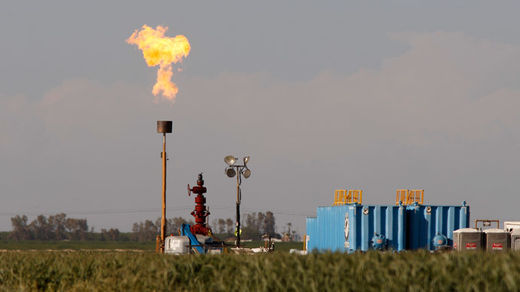
© AFP Photo / David McNew
The Environmental Protection Agency is under fire for underestimating the amount of methane gas emitted during natural gas operations, including fracking, thanks to a new study published in the
Proceedings of the National Academy of Sciences (PNAS).
The study has 13 co-authors from several academic and research institutions, and used an aircraft to identify large sources of methane and quantify emission rates in southwestern Pennsylvania in June 2012. The authors discovered that emissions rates per second were 1,000 times higher than those estimated by the EPA for the same time period.
"Methane is the second most prevalent greenhouse gas emitted in the United States from human activities," the
EPA website states. Carbon dioxide is the most prevalent, but it is not as damaging of a greenhouse gas as methane.
"Pound for pound, the comparative impact of [methane] on climate change is over 20 times greater than [carbon dioxide] over a 100-year period."
The goal of the study was to try to understand if the measurements of airborne methane differed from the measurements taken at ground level, the
Los Angeles Times reported.
"Researchers flew their plane about a kilometer above a 2,800 square kilometer area in southwestern Pennsylvania that included several active natural gas wells. Over a two-day period in June 2012, they detected 2 grams to 14 grams of methane per second per square kilometer over the entire area. The EPA's estimate for the area is 2.3 grams to 4.6 grams of methane per second per square kilometer."The researchers then traced the methane leaks back to their source; sometimes back to the individual wells at fracking sites in Pennsylvania's Marcellus Shale, according to
Salon.
"We identified a significant regional flux of methane over a large area of shale gas wells in southwestern Pennsylvania in the Marcellus formation and further identified several pads with high methane emissions," the study's authors wrote in the
Significance section for PNAS.
"These shale gas pads were identified as in the drilling process, a preproduction stage not previously associated with high methane emissions."A previous study, released in February in the journal Science, looked at 200 studies and discovered the EPA has been underestimating US methane emissions in general, as well as from the natural gas industry specifically,
Stanford University reported.
"People who go out and actually measure methane pretty consistently find more emissions than we expect," said Adam Brandt, an assistant professor of energy resources engineering at Stanford and the lead author of the February analysis.
"Atmospheric tests covering the entire country indicate emissions around 50 percent more than EPA estimates...And that's a moderate estimate."The EPA released a statement Tuesday in response to the PNAS study. The agency is aware of the discrepancies and working to alleviate them, according to the
Huffington Post.
The statement says, in part,
"We are aware of studies that draw different conclusions about the level of methane emissions from the oil and gas sector as compared to the US [Greenhouse Gas] Inventory." It also says,
"Substantial amounts of new information on the oil and gas sector will be made available in the coming years through a number of channels, including EPA's [Greenhouse Gas Reporting Program], research studies by various organizations, government and academic researchers, and industry. EPA looks forward to reviewing information and data from these studies as they become available for potential incorporation in the Inventory.""In addition, the actions included in the Administration's methane strategy, targeting both bottom-up and top-down measurement approaches, will improve the overall level of confidence in methane emissions data. We expect that as the work is carried out, and as the quality of data produced from both approaches is improved, we will increase our understanding of the reasons behind currently cited divergent results."In March, the White House ordered the EPA to identify ways to cut methane from oil and gas production, with any new rules to be in place by the end of 2016, according to the
Los Angeles Times.
It's not the CO2 or the Methane that is so troubling with fracking.
It's the toxic stuff, like Hydrogen Sulfide and heavy metals (Mercury compounds), and whatever else is buried under a couple miles of strata. The stuff that poisons water/air and kills.
And that just covers the gases. The disrupted strata and weakening of nearby or onsite fault lines is a whole different animal.
Just like everything else they disturb, no plans or actions are ever made or attempted to repair the damage.
Like taking crushed rock or mine tailings and cementing them.
Or injecting cements back into fracked strata.
It all depends on how big the mining company is.
If you are a MegaCorp, you can rip the Earth a new one, spill, pile and walk away, leaving a wasteland behind you.
The EPA and other misregulatory agencies will line up to kiss your grits. Politicians will accept your generous campaign donations and make an offering at the Altar of Money for you. The High Priests of Profit will grant you legal wormholes to slither through.
If you are a small operator, the EPA and a dozen other agencies will be all over you like vultures on a carcass.